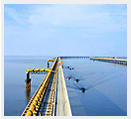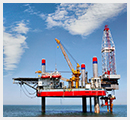 Climate change has always been focus of attention of the company. We respond to the Paris Agreement adopted by the 2015 United Nations Climate Change Conference, and we embrace the goal of limiting global warming to less than 2 degrees Celsius by the end of this century. To this end, we devote ourselves to low-carbon development, and share the practice of greenhouse gas control with industry peers and all sectors of society.
Climate change has always been focus of attention of the company. We respond to the Paris Agreement adopted by the 2015 United Nations Climate Change Conference, and we embrace the goal of limiting global warming to less than 2 degrees Celsius by the end of this century. To this end, we devote ourselves to low-carbon development, and share the practice of greenhouse gas control with industry peers and all sectors of society.
CNPC has included addressing climate change into its development plan. We have begun to formulate the roadmap for low-carbon development and started to establish the carbon emission control system. Specifically, development goals, emission reduction measures and technical routes are set, with a primary focus on carbon footprint verification, carbon emission reduction and the construction of near-zero carbon emission demonstration projects. Hereby our company endeavors to strengthen greenhouse gas management and control, and mitigate carbon dioxide and other greenhouse gas emissions from the sources, production process and product application.
In 2016, we joined the Oil and Gas Climate Initiative (OGCI) and signed the Joint Collaborative Declaration on low-carbon development. We work with international peers under the OGCI Climate Investment to address challenges of climate change. We also play an active role in developing clean energy, enhancing energy efficiency and promoting the utilization of greenhouse gases. Checking and reporting on greenhouse gas emissions are conducted inside CNPC. A Low-carbon Development Roadmap has been formulated based on analysis of the greenhouse gas emissions reduction potential and the corresponding measures across all business segments. R&D efforts were targeted at low-carbon technologies, including CCS-EOR, aviation bio-fuel production and refining energy system optimization.
Accelerating the Use of Clean Energy
Development of low-carbon and clean energy in substitution for oil and coal is a major way to address the climate change. As the advocator and practitioner of low-carbon economy, we actively develop natural gas, coal bed methane (CBM), shale gas, biomass and other low-carbon energy, produce and supply clean products, in an effort to achieve clean production of the products and consumption process. We keep strengthening the construction of facilities for gas exploration and development, and storage and transmission and work hard to promote the development and utilization of both conventional and unconventional gas. We strive to facilitate the substitution of natural gas for oil and coal in urban domestic use, power generation, chemical production, buses and taxis, in order to control emissions of greenhouse gases at the source.
Carbon Emission Reduction in Production
While supplying the society with clean oil products, we also pay much attention to optimizing the energy utilization structure within the Company. We also care about carbon emission and carbon footprint during production and operation. In Huabei Oilfield, Tarim Oilfield and other areas, we use renewable energies such as geothermal energy and solar energy to reduce carbon emissions during production.

Specifically, we enhance the comprehensive utilization of resources. Since 2013, we have put emphasis on stopping gas flaring at the remote and isolated wells, producing test wells and gas stations and refineries. By using standardized and integrated series skid-mounted equipment, and improving our techniques, we have continuously improved recovery and utilization of associated gas at Changqing, Tarim, Southwest and other oilfields.
Low Carbon Technology R&D
Focusing on the important role technological innovation plays in addressing climate change, we keep strengthening the R&D of low-carbon technologies, including studies on carbon dioxide flooding and storage, salt water layer and oil deposit carbon sequestration potential evaluation, flue gas CO2 capture at CNPC's power plants, and other key carbon reduction technologies.

We have enriched and improved a series of technology for CO2 capture, and techniques for site selection and potential evaluation of geological sequestration. As a result, we have successfully evaluated the CO2 sequestration potential in five oilfields including Changqing Oilfield and Liaohe Oilfield. In 2015, we established China's first CCUS base in Jilin Oilfield which covers the entire industrial chain, including carbon dioxide separation, capture and flooding. The Supporting Technology of CO2 Flooding and Storage and Its Application won the first prize for technological progress from the National Energy Administration.
Forestry Carbon Sequestration
We actively support carbon sink forest construction and forestation activities in China. In July 2007, CNPC established the Green Carbon Fund jointly with the State Forestry Administration and China Green Foundation (CGF). It is a special national public fund managed by CGF aimed at providing a platform for businesses, organizations and individuals to participate in voluntary activities such as tree planting and forest protection. The fund was launched on the basis of a RMB 300 million donation by CNPC. All money collected shall be used to carry out forestry carbon sink activity. It is estimated that the fund can help absorb and fix 5-10 million metric tons of carbon dioxide over the next 10 years.
In 2008, the first group of CNPC carbon sink forestation projects was piloted in Beijing, Heilongjiang, Gansu, Hebei, Hubei, Zhejiang and Guangdong.In 2011, China Green Carbon Fund worked with Huadong Forest Property Exchange to launch a forest carbon sink pilot in Yiwu, Zhejiang Province. In 2012, we spent RMB 6 million to create a carbon sequestration forest covering an area of 13.33 hectares in Beijing. From 2010 to 2012, we have donated a total of RMB 12 million to Chongqing to create forests in the Three Gorges Reservoir Region.
By the end of 2014, in the carbon sequestration forest project in Xinjiang Oilfield which was started in 2001, 48 million trees had been planted in the desert, covering an area of 986.67 hectares. In 2015, we invested RMB 148.99 million in public-welfare forestation funds and planted over one million trees. As of the end of 2019, our green coverage reached 286 million square meters, representing an increase of 5.595 million square meters in the year. A total of 499,000 employees voluntarily planted 2.027 million trees in 2019.
Carbon Transaction
We actively participate in carbon trading activities to achieve carbon emission reduction through market-based mechanisms. We are a co-founder of the Tianjin Climate Exchange (TCE), the first comprehensive emissions trading institution in China. The energy saving and emission reduction projects developed by TCE expected to save more than 200,000 tons of standard coal annually, equivalent to over 500,000 tons of CO2 emissions reduction. In 2019, all CNPC enterprises on the list of the national carbon emissions trading market fulfilled their contracts.
Utilization of Renewable Resources
We keep promoting the evaluation, development and utilization of biomass energy, geothermal energy, wind energy and solar energy, and hydrogen energy, in order to control greenhouse gas emissions at source.
We have built a large-scale distributed photovoltaic power station at the Jilin Oilfield, with a maximum daily generating capacity of 100,000 KWh and annual generating capacity of 22.5 million KWh. Compared with coal-fired power plants with the same capacity, the PV power station can reduce 18,700 tons of CO2 emissions, 1.425 million tons of SO2 emissions and 48 tons of NO2 emissions.
In Huabei Oilfield, we conduct pilot tests for the comprehensive utilization of geothermal energy, and have made considerable achievements in geothermal power generation, heating, and heat tracing for oil transportation. Liaohe Oilfield independently developes shallow recirculation technology, enabling the industrial application of geothermal resources, with more than 10 projects completed for applying groundwater source heat pumps. In Tarim Oilfield, we use solar energy to renovate 10 test well stations, which may reduce diesel oil consumption by 1,200 metric tons and cut CO2 emissions by 5,000 metric tons every year, saving over RMB 10 million in fuel costs.
Huabei Oilfield has formulated the Geothermal Utilization Development Plan of Huabei Oilfield Company (2018-2025) to facilitate the building of the green and intelligent new city of Xiong'an New Area. Relying on the advantages of mid and low-temperature geothermal resources of the oilfield, it has built a "geothermal +" economic growth pole to promote the upgrade of local clean energy consumption.









